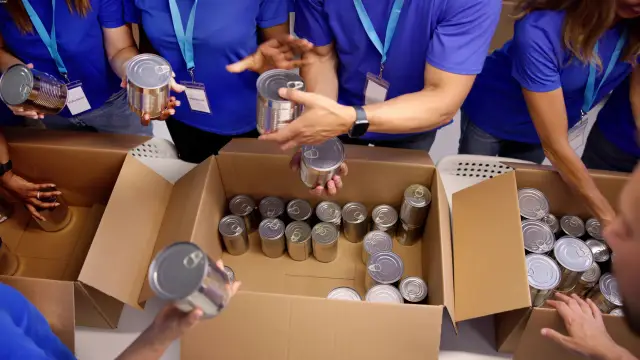Disconnected and Overloaded: Why Food Banks Need IT Support
Feeding The Hungry: Why IT Challenges Are Holding Food Banks Back
Across the United States, food banks play a critical role in feeding individuals and families facing food insecurity. Organizations and local community pantries form the backbone of a compassionate, life-saving network. But behind the scenes, many of these nonprofits are struggling with technology infrastructure that isn’t keeping pace with their growing mission. In fact, outdated or fragmented IT systems often limit their ability to serve efficiently and transparently.
In today’s data-driven world, the ability to collect, share, and act on information is just as important as the food on the shelves. From tracking inventory and coordinating deliveries to collecting client data and reporting to funders, technology should be the bridge that connects resources to the people who need them most. Instead, for many food banks, it’s become a bottleneck.
Let’s take a closer look at four major areas where IT pain points are slowing down hunger relief and what can be done to solve them.
1. Data Silos, Manual Entry, and the Reporting Trap
Most food banks rely on some form of data tracking—such as how many families they serve, what food is distributed, and which zip codes need more support. But in many cases, this information lives in spreadsheets, is manually entered, or is housed in different systems that don’t “talk” to each other. This fragmented data landscape creates multiple challenges:
-
Double entry and errors
-
Delays in reporting
-
Inability to measure true impact
-
Missed funding opportunities due to lack of real-time insights
For example, a small food pantry in rural communities may collect intake data on paper forms, then enter it into a basic spreadsheet once a week. Meanwhile, the state food bank or central distributor can’t see that data in real time, meaning food deliveries aren’t optimized based on current demand. Multiply that scenario by dozens of locations, and you can see how hard it is to respond efficiently to community needs.
Solution: A cloud-based, integrated data platform can streamline intake processes, track inventory in real-time, and unify reporting metrics. Not only does this save staff time, it builds confidence with donors and grant-makers who want evidence of impact.
2. Gaps in Digital Connectivity and System Integration
Another persistent challenge, especially in more remote or low-income areas, is the lack of digital infrastructure. Some food bank partners don’t have reliable broadband, updated devices, or modern IT systems. Others rely on legacy software or outdated hardware that can’t handle modern applications. This digital divide doesn’t just affect the staff—it also limits how clients interact with services. For example:
-
Families without internet access may struggle to register online for food assistance
-
Agencies may be unable to adopt logistics or inventory software due to poor connectivity
-
Disparate systems between partner agencies mean data has to be re-entered manually
All of this reduces efficiency and makes it harder to deliver timely, equitable service.
Solution: Public-private partnerships can help bridge the connectivity gap, by providing affordable internet access and upgrading key equipment. IT support providers and managed service partners can also help nonprofits assess current systems, recommend affordable tools, and support training for staff.
3. Downtime
Downtime is one of the most disruptive IT issues food banks can face. Whether it’s caused by outdated hardware, unreliable internet, or software glitches, even a short period of system unavailability can halt operations. Staff may be unable to check in clients, track inventory, or coordinate deliveries, leading to long wait times, wasted food, and frustrated families. For organizations already stretched thin, every minute lost to downtime impacts both efficiency and trust. Implementing stable infrastructure, backup systems, and proactive IT support is essential to keep food bank operations running smoothly and continuously.
Solution: To reduce downtime, food banks need reliable infrastructure and proactive support. Upgrading outdated systems, using cloud-based tools, and setting up real-time monitoring can prevent disruptions. Partnering with an IT provider ensures quick issue resolution and keeps operations running smoothly.
4. Security Risks and Missed Opportunities for Innovation
Nonprofits, including food banks, are not immune to cybersecurity risks. In fact, many are seen as easy targets because they often lack robust protections. A data breach could mean exposure of sensitive donor or client data—and legal or reputational damage. Unfortunately, security is often an afterthought due to budget constraints.
At the same time, food banks are missing opportunities to adopt innovative tools—such as blockchain for tracking donations, AI for demand forecasting, or mobile apps for clients—simply because they lack the IT strategy or resources to pursue them.
Solution: A proactive cybersecurity plan, including firewalls, endpoint protection, and staff training, is essential. In addition, food banks should consider partnering with IT providers who understand the nonprofit sector and can help prioritize affordable, high-impact technology investments.
Conclusion: Building a More Resilient Hunger-Relief Network
Food insecurity is a growing challenge, but food banks don’t have to face it alone—or without the right tools. By investing in IT modernization, connectivity, cybersecurity, and data integration, food banks can become more agile, more transparent, and more effective. It’s not about fancy tech—it’s about mission delivery. And in the end, every system improvement helps get more food into the hands of those who need it most.
Is your food bank struggling with outdated systems or data silos? Let’s talk. We specialize in building secure, modern IT environments—so you can focus on serving your community.
Follow us on social media and stay connected, subscribe to our YouTube channel.
If you need assistance with these topics, contact us, we’ll be happy to help.
#foodbank #NPO #nonprofit #foodinsecurity #endhunger #donate #giveback #digitaltransformation #innovation #fundraising #fundraiser #socialimpact #OrangeCounty #LACounty #UtahCounty #SaltLakeCity #ParkCity #Provo #Highland #Lehi #Draper #Orem #Ogden #Lindon #Vineyard #SaratogaSprings #AmericanFork #PleasantGrove #StGeorge #Lehi #SpanishFork #Springville

